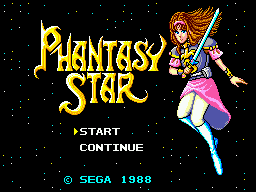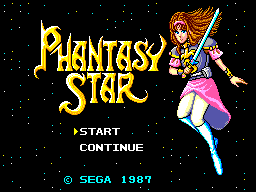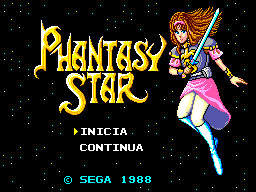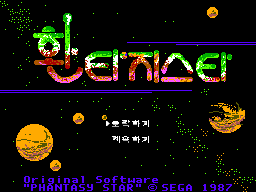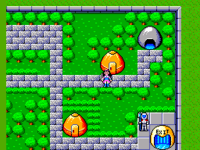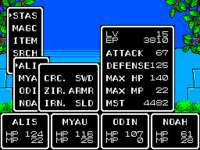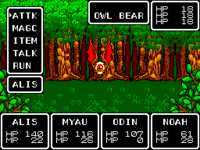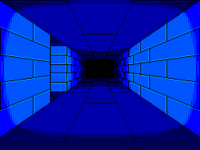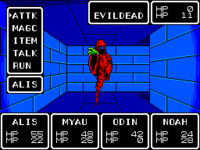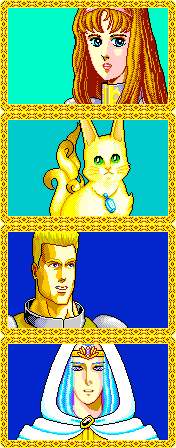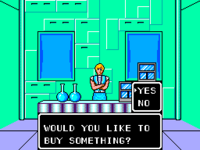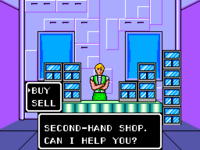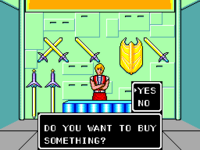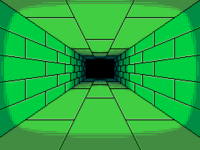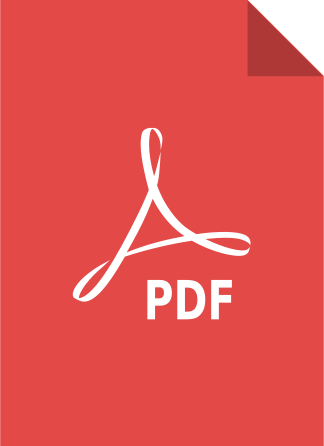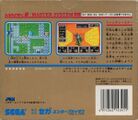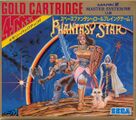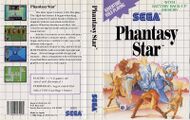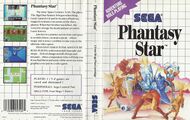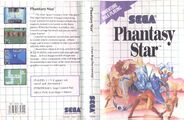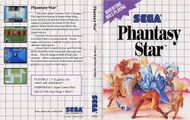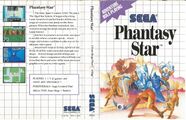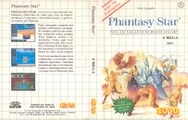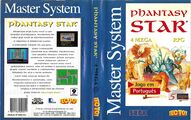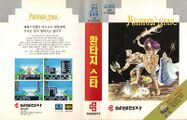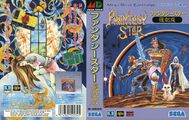Phantasy Star
From Sega Retro
| ||||||||||||||||||||||||||||||||||||||||||||||||||||||||||||||||||||||
| Phantasy Star | ||||||||||||||||||||||||||||||||||||||||||||||||||||||||||||||||||||||
|---|---|---|---|---|---|---|---|---|---|---|---|---|---|---|---|---|---|---|---|---|---|---|---|---|---|---|---|---|---|---|---|---|---|---|---|---|---|---|---|---|---|---|---|---|---|---|---|---|---|---|---|---|---|---|---|---|---|---|---|---|---|---|---|---|---|---|---|---|---|---|
| System(s): Sega Master System, Sega Mega Drive, Virtual Console | ||||||||||||||||||||||||||||||||||||||||||||||||||||||||||||||||||||||
| Publisher: Sega | ||||||||||||||||||||||||||||||||||||||||||||||||||||||||||||||||||||||
| Developer: Sega R&D 2 M2[1] | ||||||||||||||||||||||||||||||||||||||||||||||||||||||||||||||||||||||
| Peripherals supported: FM Sound Unit | ||||||||||||||||||||||||||||||||||||||||||||||||||||||||||||||||||||||
| Genre: RPG[2][3][4][5], Adventure Role-Playing[6] | ||||||||||||||||||||||||||||||||||||||||||||||||||||||||||||||||||||||
| Number of players: 1 | ||||||||||||||||||||||||||||||||||||||||||||||||||||||||||||||||||||||
| Official in-game languages: | ||||||||||||||||||||||||||||||||||||||||||||||||||||||||||||||||||||||
|
Phantasy Star (ファンタシースター) is a Sega Master System role-playing game developed by Sega R&D 2 and published by Sega. First released in Japan in December 1987, the game is the first in the long-running Phantasy Star series, and was released to critical and commercial success. It is regarded as a landmark RPG as well as one of the greatest Master System games. It is notable for its "science fantasy" setting, which blends medieval fantasy and science fiction, and for being an early example of a game with a female protagonist.
Contents
Story
The game is set in the Algol star system, which consists of three planets: the lush and green Palma, the arid and barren Motavia, and the icy and desolate Dezoris. Algol is ruled by King Lassic, who, while originally benevolent, becomes a cruel tyrant. After a string of harsh political changes, small pockets of rebellion emerge but are mostly ineffective against Lassic's iron rule. One such rebel named Nero is killed by Lassic's forces, and his sister Alis swears revenge.
Gameplay
Phantasy Star is a role-playing game. The player controls the main character Alis on her journey to defeat the evil ruler of her star system, King Lassic, after her brother dies at his hands. As the game progresses, other characters are recruited to her party: a talking cat-like creature named Myau, a warrior named Odin, and a wizard named Noah. Each character has different strengths, weaknesses, and abilities. The party has a shared inventory of items and equipment.
The game uses a top-down perspective when the player is traversing the overworld but switches to a first-person view when exploring dungeons or engaged in battle. When exploring the overworld, the player can venture into a town to buy items and weapons in meseta, the game's currency, or talk to townspeople. Later in the game, the party acquires vehicles to help navigate tricky terrain in the overworld. Outside the towns, monsters may randomly engage the player in battle. The player can enter dungeons and caves from the overworld. Dungeons use a simulated 3D perspective. They are long and labyrinthine and require the player to map most of them on paper (or to use a guide or other resource). Many dungeons are dark and require the player to use an item to illuminate them. Dungeons include random encounters with monsters as well as unique encounters against boss characters. Dungeons can also contain treasure chests and NPCs, including vendors.
When encountering enemies, all party members enter into battle. Battles are handled using a menu system. Each character in the party gets a turn and can be ordered to attack, use magic, use an item, or try to escape the encounter. The player can also attempt to talk to an enemy to avoid a battle. Battles can involve multiple foes of the same type, but only one is shown; the player cannot choose a particular enemy to target. Enemies attack and sometimes use magic spells. Allies and enemies both have a chance to miss with their attacks. Characters and enemies are defeated when they run out of hit points. When the enemies are defeated, party members gain experience points and are rewarded with a treasure chest that usually contains meseta or an item. Some treasure chests contain booby traps that damage the party, so the player can choose not to open the chest.
As the characters gain experience points, they increase in level (up to a maximum level of 30), gaining access to new magic spells and raising their offensive and defensive statistics:
- Max HP: The maximum number of hit points for the character, which is the amount of damage that the character can sustain from enemy attacks before dying.
- Max MP: The maximum number of magic points for the character, which can be spent to use magic abilities.
- Attack: Increases the damage done by attacks. This statistic can be increased by weapons.
- Defense: Reduces the damage taken from enemy attacks. This statistic can be increased by armor.
If Alis is defeated in battle, the game ends; other party members can be revived at a church in town. Characters can be healed using spells, consumable items, or hospitals (for a fee). Some towns contain houses where the party can replenish their hit points and magic points for free.
The story spans the three worlds of the Algol system. Alis and her party can travel between the planets of Palma, Motavia, and Dezoris at spaceports after acquiring a Passport.
When out of battle, the player can invoke a menu with ![]() to view the status of any character, manage items, or save the game at any point.
to view the status of any character, manage items, or save the game at any point.
Characters
| Alis (アリサ) | ||||||||||||||||||||
|---|---|---|---|---|---|---|---|---|---|---|---|---|---|---|---|---|---|---|---|---|
The main character. Her brother is killed by Lassic, and she vows revenge. She is a strong fighter and learns several utility spells, though her pool of magic points is relatively limited.
| ||||||||||||||||||||
| Myau (ミャウ) | ||||||||||||||||||||
A "musk cat," an unusual creature resembling a cat and a companion to Odin. Alis finds Myau in Motavia, and he joins to find Odin. He transforms into another form after consuming a Laerma nut. He learns a number of defensive spells.
| ||||||||||||||||||||
| Odin (タイロン) | ||||||||||||||||||||
| Odin is a legendary fighter who was turned to stone by Medusa. Alis finds Odin in Palma, and he joins after Myau restores him. He has a powerful attack but does not learn any magic. | ||||||||||||||||||||
| Noah (ルツ) | ||||||||||||||||||||
Noah is an esper wizard. Alis finds Noah in Motavia, and he joins to help stop King Lassic. He learns a number of offensive spells.
|
Town
Towns contain numerous buildings that Alis and the party can enter to talk with NPCs or purchase items, equipment, or services.
| House | |
|---|---|
| Houses contain NPCs, who provide information. Suelo's house in Camineet provides healing for free. | |
| Shop | |
| There are three types of shops: the First Food Shops, which sell healing items; Second-Hand Shops, which sell other consumable items; and Armorers, which sell weapons and armor. The player can also sell items at Second-Hand Shops for half of their purchase price. | |
| Hospital | |
| Party members can have their hit points and magic points restored for a fee at a hospital. | |
| Church | |
| Fallen allies can be resurrected in a church for a donation in meseta. | |
| Dungeon | |
| Enters a dungeon located within the town. | |
| Exit | |
| Leaves the town and returns to the overworld. |
Items
Consumable
| Item | Cost (in meseta) | Description |
|---|---|---|
| Cola | 10 | Restores 10 hit points to a character. |
| Burger | 40 | Restores 40 hit points to a character. |
| Flash | 20 | Illuminates a dark dungeon. Lasts until the dungeon is exited. |
| Escape | 10 | Allows the party to run from a battle. |
| Transer | 48 | Teleports the party back to the last visited church. Can only be used out of battle. |
| Magic Hat | 20 | Allows the party to run from a battle. Talks to certain enemies, including enemies who do not respond to the TALK command. Equivalent to the CHAT spell. |
| Sphere | 30 | Talks to certain enemies, including enemies who do not respond to the CHAT spell or TALK command. Equivalent to the TELE spell. |
Reusable
| Item | Cost (in meseta) | Description |
|---|---|---|
| Road Pass | 200 | Used to pass guards to access the moving platforms. |
| Passport | 100 | Used to travel to other planets at a spaceport. |
| Dungeon Key | — | Unlocks doors in dungeons. |
| Compass | — | Shows the direction that the characters are facing. Useful for navigating dungeons. Also necessary to enter Eppi Forest. |
| Magic Lamp | 1,400 | Illuminates dark dungeons. |
| Flute | — | Teleports the party to the entrance of the current dungeon. |
| Gas Shield | 1,000 | Protects against poison gas. |
| Landrover | 5,200 | Vehicle that travels quickly over flat terrain. Also crosses over Antlion nests on Motavia. |
| Hovercraft | 5,200 | Vehicle that travels over water or lava. |
| Ice Digger | 12,000 | Vehicle that breaks through ice on Dezoris. |
Equipment
Weapons
Swords, wands, and fangs do a high amount of damage to a single enemy each turn. Guns hit every enemy once per turn for less damage. The amount of damage done by swords, wands, and fangs varies randomly, but guns consistently do the same damage.
| Weapon | Cost (in meseta) | Shop | Attack | Equippable by |
|---|---|---|---|---|
| Woodcane | 25 | Albion | 3 | Noah |
| Short Sword | 30 | Paseo | 4 | Alis, Odin, Noah |
| Iron Axe | 64 | Eppi | 10 | Odin |
| Iron Fang | — | — | 10 | Myau |
| Wand | 1,200 | Skure | 10 | Alis, Odin, Noah |
| Iron Sword | 75 | Parolit | 12 | Alis, Odin |
| Needle Gun | 400 | Eppi | 18 | Odin |
| Titanium Sword | 380 | Parolit | 21 | Alis, Odin |
| Heat Gun | 1,540 | Uzo | 30 | Odin |
| Silver Fang | 1,620 | Loar | 30 | Myau |
| Ceramic Sword | 1,120 | Parolit | 31 | Alis, Odin |
| Light Saber | 2,980 | Uazo | 46 | Alis, Odin |
| Laser Gun | 4,120 | Skure | 50 | Odin |
| Laconian Sword | — | — | 60 | Alis |
| Laconian Axe | — | — | 80 | Odin |
Armor
| Armor | Cost (in meseta) | Shop | Defense | Equippable by |
|---|---|---|---|---|
| Leather Armor | 28 | Scion | 5 | Alis, Odin |
| White Mantle | 78 | Loar | 5 | Noah |
| Light Suit | 290 | Scion | 15 | Alis, Odin |
| Iron Armor | 84 | Abion | 20 | Odin |
| Thick Fur | 630 | Paseo | 30 | Myau |
| Zircon Armor | 1,1000 | Scion | 30 | Alis, Odin |
| Frad Mantle | — | — | 40 | Noah |
| Diamond Armor | 15,000 | Paseo | 60 | Alis, Odin |
| Laconian Armor | — | — | 80 | Odin |
Shields
| Armor | Cost (in meseta) | Shop | Defense | Equippable by |
|---|---|---|---|---|
| Leather Shield | 30 | Camineet | 3 | Alis, Odin |
| Bronze Shield | 310 | Eppi | 8 | Odin |
| Iron Shield | 520 | Camineet | 15 | Alis, Odin |
| Ceramic Shield | 1,400 | Camineet | 23 | Alis, Odin |
| Laser Shield | 4,800 | Abion | 30 | Alis, Odin, Noah |
| Gloves | 3,300 | Skure | 40 | Myau |
| Mirror Shield | — | — | 40 | Odin |
| Laconian Shield | — | — | 05 | Alis, Odin |
Spells
| Spell | MP cost | Description | Learned by |
|---|---|---|---|
| BYE | 2 | Escapes a battle. Can only be cast in battle. | Alis |
| CHAT | 2 | Talks to certain enemies, including enemies who do not respond to the TALK command. Can only be cast in battle. | Alis |
| CURE | 6 | Restores 80 hit points to a character. Can only be cast in battle by Myau and only out of battle by Noah. | Myau, Noah |
| EXIT | 4 | Teleports the party out of a dungeon. Can only be cast in a dungeon. | Myau, Noah |
| FIRE | 4 | Shoots fireballs at two random enemies. Can only be cast in battle. | Alis, Noah |
| FLY | 8 | Teleports the party to the last visited church. Can only be cast out of battle. | Alis |
| HEAL | 2 | Restores 20 hit points to a character. Can be cast at any time. | Alis |
| HELP | 10 | Increases the attack power of a character. Can only be cast in battle. | Myau |
| OPEN | 4 | Opens magically sealed doors. Can only be cast out of battle. | Noah |
| PROT | 10 | Creates a magical barrier that protects the party against physical attacks. Can only be cast in battle. | Noah |
| RISE | 12 | Revives a fallen ally. Can be cast at any time. | Noah |
| ROPE | 4 | Binds an enemy, preventing it from acting. Can only be cast in battle. | Alis |
| TELE | 4 | Talks to certain enemies, including enemies who do not respond to the CHAT spell or TALK command. Can only be cast in battle. | Noah |
| TERR | 2 | Frightens and weakens enemies. Can only be cast in battle. | Myau |
| THUN | 16 | Summons lightning to strike every enemy. Can only be cast in battle. | Noah |
| TRAP | 3 | Inspects the area in front of the party, including treasure chests, for traps and disables any that it finds. Can only be cast out of battle. | Myau |
| WALL | 10 | Creates a magical barrier that protects the party against physical attacks. Can only be cast in battle. | Myau |
| WIND | 12 | Conjures cyclones that damage three random enemies. Can only be cast in battle. | Noah |
History
Development
| “ | I think the success of Phantasy Star lies in the fact that the development staff was given the freedom to make the game we wanted, without restrictions or control. I wanted to create something that the Famicom wouldn't have been able to do, so I wanted the dungeons to be in 3D. When I think back on the story now, there were a lot of ridiculous things in it, but we were able to do it how we wanted, had fun while we were doing it, and the result was a good game. After all, if you're having fun, you can give it your all even when things gets tough. | „ |
The game was conceptualized to compete with other RPGs that were becoming popular among Japanese developers, including the Dragon Quest series on the Famicom. Employees at Sega R&D2 were asked for ideas for a new RPG, and Chieko Aoki submitted a story outline that would become Phantasy Star. A development team was formed by lead designer Kotaro Hayashida and lead programmer Yuji Naka. Naka would later produce Phantasy Star Online. The game features the work of lead artist Rieko Kodama, who had previously worked with Hayashida on Alex Kidd in Miracle World and who drew the majority of the artwork in the game. Kodama would go on to direct or produce the RPGs Phantasy Star IV, Magic Knight Rayearth, and Skies of Arcadia. It is also the first game that Naoto Ohshima worked on. Naka, Kodama, and Ohshima would notably work together again on Phantasy Star II and Sonic the Hedgehog.
| “ | Regarding the 3D, we would get an image of the dungeon in our head and draw them out on paper, but there were little details that bugged us and it wasn't getting across to the programmers as we had envisioned it. Yuji Naka learned of this and, on his own, made a wireframe 3D imaging program expressly for us. That program was also the start of Shibata learning to draw 3D graphics.
That was what was amazing about Yuji: he would never just say "that can't be done" to a planning or design idea. He thought about our wishes seriously and would always figure out some ingenuous way to make our ideas possible. He was very considerate of the designer's vision, in other words. |
„ |
The game uses a 4 Mbit cartridge, a large size for the time. The only other Master System games to use such a large ROM chip are After Burner, SpellCaster, and R-Type. The game also uses a battery backup, which made its retail price higher than most other games of its time.
Legacy
In 1994, Sega released a version for the Sega Mega Drive, Phantasy Star Fukkokuban (ファンタシースター 復刻版). This version is merely the Master System version on a Mega Drive cartridge PCB with the appropriate connector pin to signal Master System mode changed accordingly (which is how passthrough devices like the Power Base Converter work.)[19] The situation behind this release is unknown, but it is generally believed that it was a contest giveaway.[20]
The game has been re-released many times. It was included in Sega Ages Phantasy Star Collection for the Sega Saturn in 1998. This version of the game includes both hiragana and katakana alphabets, an improvement from the original, which had only katakana due to memory constraints. It was released as part of Phantasy Star Collection for the Game Boy Advance in 2003. This version modifies the game slightly to fit the Game Boy Advance's screen aspect ratio and fixes some errors in the English translation. It was released as part of Phantasy Star Complete Collection for the PlayStation 2 in 2008, with some minor enhancements such as the ability to speed up the walking speed. It is available as an unlockable in Sega Mega Drive Ultimate Collection, released for the PlayStation 3 and Xbox 360 in 2009. It was made available on the Wii's Virtual Console service in 2009. More recently, it was ported to the Nintendo Switch by M2 as Sega Ages Phantasy Star in 2018. This version of the game includes enhancements such as options to make the game easier and faster, guides for items, spells, and monsters, the FM soundtrack, hiragana support, and a dungeon auto-mapping feature.
The game was remade as Phantasy Star Generation: 1 for the PlayStation 2. This version has new graphics, real-time 3D dungeons, new music, more cutscenes with extended dialogue, and overhauled gameplay mechanics, including an updated battle system.
Versions
Localised names
| Language | Localised Name | English Translation |
|---|---|---|
| English | Phantasy Star | Phantasy Star |
| English (US) | Phantasy Star | Phantasy Star |
| Japanese | ファンタシースター | Phantasy Star |
| Portuguese (Brazil) | Phantasy Star | Phantasy Star |
| Korean | 환타지스타 | Phantasy Star |
Production credits
- Main article: Phantasy Star/Production credits.
Hints
Magazine articles
- Main article: Phantasy Star/Magazine articles.
Promotional material
also published in:
- Electronic Gaming Monthly (US) #1: "May 1989" (1989-0x-xx)[21]
- Electronic Gaming Monthly (US) #2: "July/August 1989" (1989-04-22)[22]
- Electronic Gaming Monthly (US) #3: "September/October 1989" (1989-0x-xx)[23]
Artwork
Physical scans
Master System version
| Sega Retro Average | ||||||||||||||||||||||||||||||||||||||||||||||||||||||||||||||||||||||||||
|---|---|---|---|---|---|---|---|---|---|---|---|---|---|---|---|---|---|---|---|---|---|---|---|---|---|---|---|---|---|---|---|---|---|---|---|---|---|---|---|---|---|---|---|---|---|---|---|---|---|---|---|---|---|---|---|---|---|---|---|---|---|---|---|---|---|---|---|---|---|---|---|---|---|---|
|
| 86 | |
|---|---|
| Based on 14 reviews | |
| Master System, DE |
|---|
|
Mega Drive version
| Sega Retro Average | |||||||||||||||||||
|---|---|---|---|---|---|---|---|---|---|---|---|---|---|---|---|---|---|---|---|
|
| 70 | |
|---|---|
| Based on 3 reviews | |
Virtual Console version
Technical information
- Main article: Phantasy Star/Technical information.
ROM dump status
| System | Hash | Size | Build Date | Source | Comments | |||||||||
|---|---|---|---|---|---|---|---|---|---|---|---|---|---|---|
| ? |
|
512kB | Cartridge (BR) | 8kB backup | ||||||||||
| ? |
|
512kB | Cartridge (EU/US) | 8kB backup | ||||||||||
| ? |
|
512kB | Cartridge (EU/US) | 8kB backup | ||||||||||
| ? |
|
512kB | Cartridge (JP) | 8kB backup | ||||||||||
| ? |
|
512kB | Cartridge (KR) | 8kB backup |
External links
- Phantasy Star section at Phantasy Star Cave
- Sega of Japan Virtual Console pages: Master System
- Nintendo catalogue pages: US, AU
References
- ↑ https://www.mtwo.co.jp/development/retrogame-2/#tab-2
- ↑ File:Phantasy Star MD JP Box.jpg
- ↑ 3.0 3.1 https://sega.jp/history/hard/megadrive/software.html (Wayback Machine: 2020-07-20 09:51)
- ↑ 4.0 4.1 https://sega.jp/history/hard/segamark3/software.html (Wayback Machine: 2020-11-14 21:32)
- ↑ File:PhantasyStar SMS KR cover.jpg
- ↑ File:PhantasyStar SMS EU cover.jpg
- ↑ Computer Entertainer, "December 1988" (US; 1988-12-17), page 13
- ↑ VideoGames & Computer Entertainment, "August 1989" (US; 1989-0x-xx), page 30
- ↑ File:1988 89 SMS UK Catalogue.pdf, page 2
- ↑ ACE, "January 1989" (UK; 1989-xx-xx), page 166
- ↑ Supergame, "Setembro 1991" (BR; 1991-09-xx), page 29
- ↑ 12.0 12.1 http://www.nintendo.com/games/detail/liCGd--387PDpgcfX7CfYK4-c94D4wf6 (Wayback Machine: 2010-11-22 22:48)
- ↑ 13.0 13.1 http://www.nintendolife.com/games/mastersystem/phantasy_star (Wayback Machine: 2017-06-25 02:43)
- ↑ https://www.nintendo.fr/Jeux/Console-virtuelle-Wii-/Phantasy-Star--278491.html (archive.today)
- ↑ https://www.nintendo.co.jp/wii/vc/software/10.html (Wayback Machine: 2018-03-05 23:33)
- ↑ http://vc.sega.jp:80/vc_ms_ps1 (Wayback Machine: 2009-04-29 04:03)
- ↑ http://www.nintendo.com.au/index.php?action=catalogue&prodcat_id=42&prod_id=19899&pageID=4 (Wayback Machine: 2012-04-03 03:28)
- ↑ 18.0 18.1 https://shmuplations.com/phantasystar/
- ↑ https://nicole.express/2021/composite-conflict-completed.html
- ↑ Electronic Gaming Monthly, "December 1993" (US; 1993-xx-xx), page 65
- ↑ Electronic Gaming Monthly, "May 1989" (US; 1989-0x-xx), page 47
- ↑ Electronic Gaming Monthly, "July/August 1989" (US; 1989-04-22), page 68
- ↑ Electronic Gaming Monthly, "September/October 1989" (US; 1989-0x-xx), page 55
- ↑ Supergame, "Novembro 1991" (BR; 1999-11-xx), page 14
- ↑ Complete Guide to Consoles, "" (UK; 1989-10-16), page 63
- ↑ Complete Guide to Consoles, "Volume IV" (UK; 1990-11-xx), page 103
- ↑ Console XS, "June/July 1992" (UK; 1992-04-23), page 143
- ↑ Computer & Video Games, "March 1989" (UK; 1989-02-xx), page 93
- ↑ Micromanía (segunda época), "Abril 1990" (ES; 1990-0x-xx), page 54
- ↑ Mean Machines Sega, "October 1992" (UK; 1992-09-xx), page 135
- ↑ Power Play, "12/88" (DE; 1988-11-07), page 68
- ↑ S: The Sega Magazine, "June 1990" (UK; 1990-05-03), page 11
- ↑ Sega Power, "October 1991" (UK; 1991-09-05), page 58
- ↑ Sega Power, "December 1991" (UK; 1991-10-30), page 46
- ↑ Sega Pro, "March 1992" (UK; 1992-02-20), page 21
- ↑ Sega Pro, "April 1993" (UK; 1993-03-11), page 72
- ↑ Tilt, "Mars 1989" (FR; 1989-0x-xx), page 110
- ↑ Zzap!, "Luglio 1991" (IT; 1991-xx-xx), page 68
- ↑ 1700 igr dlya Sega, "" (RU; 2001-xx-xx), page 233
- ↑ Beep! MegaDrive, "April 1994" (JP; 1994-03-08), page 20
- ↑ Sega Saturn Magazine, "September 1995" (JP; 1995-08-08), page 85
| Phantasy Star | |
|---|---|
|
Main page | Comparisons | Maps | Credits | Magazine articles | Reception | Region coding | Bootlegs
Music: Phantasy Star (Q3 2) | |
- FM Sound Unit-compatible games
- 1 player games
- JP Master System games
- US Master System games
- EU Master System games
- DE Master System games
- UK Master System games
- BR Master System games
- KR Master System games
- Master System games
- 1987 Master System games
- All 1987 games
- Master System adventure games
- All adventure games
- JP Mega Drive games
- Mega Drive games
- 1994 Mega Drive games
- All 1994 games
- Mega Drive adventure games
- JP Wii Virtual Console games
- US Wii Virtual Console games
- EU Wii Virtual Console games
- AU Wii Virtual Console games
- Wii games
- 2009 Wii games
- All 2009 games
- Wii Virtual Console games
- All games
- Old technical information
- Phantasy Star
- Phantasy Star (franchise)
- Phantasy Star (classic)
- Big box Master System games
